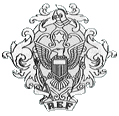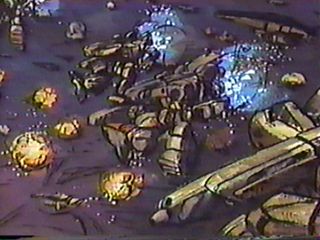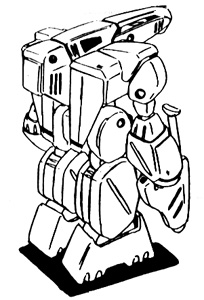

Designation:Main Battle Robot MBR-12 Mk II Condor |

|
||||

|
|||||
| Total Height: | 8.2m |
| Total Depth: | 5.4m |
| Total Breadth: | 5.0m |
| Weight: | 25.7 metric tons (dry) |

A space booster pack is available; it carries two PSE-11D engines and reaction mass for 3.4 kps delta-v.
The armor on the Condor is a new development in low-mass composite-materials Chobham plating that became the standard for all Terran mecha after its application to the VQ-6A Vandal. Aside from the respectable protection provided against projectiles, missiles, and other kinetic weapons, this armor is also resistant to plasma globes (annihilation discs), lasers, and to a lesser extent, particle guns, owing to the fact that the armor can flake off and evaporate in layers under fire from such high-energy weapons, taking much of the weapon's energy and converting it into the latent heat of sublimation in the armor. The armor stops all small arms, heavy infantry weapons fire, and light mecha-mounted weaponry, and provides fair to good resistance to medium mecha-mounted weaponry, such as the Valkyrie's 55mm APFSDS round.
The Condor provides full protection from nuclear, biological, and chemical hazards, using an overpressure cockpit environment activated by radiation and hazardous chemical sensors, or manually when biological warfare conditions are anticipated. The internal consumables supplies can provide atmosphere for three days maximum.

For some time, the REF planners had considered building a mecha with a mobility not unlike that of the Glaug: very fast, and reasonable jump/hover capabilities. Also, this mecha would have the firepower of a Glaug, as well as Destroid level armor. This mecha would then serve as the premier fast strike mecha of the REF.
A solution to the specifications was sought by re-using the existing frame of one of the newer, smaller Destroids. The first choice was the Gladiator, but this design effort was halted after a few months, as there was no conceivable way in which additional mobility could be added to a Destroid without unacceptable degradations in armor and armament levels. Then, the design team turned toward a Veritech frame, under the assumption that uparmoring an already highly mobile Battloid would be easier than downarmoring a slow and heavy Destroid. However, the VF-4 frame was unsuited for the uparmoring deemed necessary, the VF-1 Battloid too old and in the process of leaving the service, and the VAX canceled; and thus, more by necessity than by suitability, the Alpha frame was chosen as the conversion starting point. However, the development of the newer armor plating which enhanced Veritech Battloid survivability some, caused the project to be suspended during its definition phase.
During the taking of Tirol, however, the REF was once again opposed by mecha with far superior mobility: namely, the Invid Scouts and Troopers. As the REF troops were unprepared to fight an air-mobile army, initial losses were quite high. Consequently, a crash program was started to equip the REF Armies with more mobile mecha, and the cavalry mecha project was re-activated.
The result was the Condor Mobile Battloid. The Condor emerged as a Battloid with limited hover and flight capabilities. Despite the use of a main engine package virtually identical to that in the VF-6A Alpha (the ATF 401 engines were removed from the off-the-shelf Alpha arms and the nozzles armored over), the added armor and limited airflow made sustained hover impossible, and for longer deployments the Condor would resort to jumping across ground obstacles.
Outwardly, this mecha could be recognised as an descendant of the Alpha by the general hull structure, the large aft-placed cockpit module, the intakes located on the chest and (now unused) auxiliary engine bulges in the arms. However, the central chest and head area were completely remodelled, and ended up not unlike the face area of the Quaedluun-Rau Power Armor. In action however, the Condor ended up more often than not as a recon Battloid, and was then equipped with a snout-like extra sensor pod, which mounted on the faceplate. The armor, which on the Alpha had by necessity been limited due to the needed transformational nature, was significantly increased in mass, although the total protection did not come near that considered to be standard for Earth Destroids.
The armament philosophy was completely renewed, as the Condor could not mount the full missile armament of the Alpha. The number of missiles was only about two-thirds of what the Alpha carried. The cannon armament, however, was far superior to the GU-13 on the early Alphas. The EP-12, an enormous tri-barreled particle beam gun was carried by the right arm, later serving as the model for the Alphas' later EP-13 beam gun pod.
Operationally, the Condor suffered drawback after drawback. Most importantly, the REF adopted new tactics to deal with the Invid mecha. This was started by the observation that the Alphas and Betas were far better in aerial combat than their Invid counterparts, and that the Destroids with their heavy armaments and superb battlefield staying power far outclassed the Invid mecha on the ground. Thus, the REF adopted a combined-weapons tactic which pitted the Invid against each Earth mecha type on its most favorable terms. For instance, Alphas no longer served Infantry duty in Battloid mode unless absolutely necessary, to the great relief of the Air Force pilots. (It should be noted, however, that the REF Marines were a significant exception to this rule, earning a reputation for piloting the Alpha like a mobile Destroid with enormous - indeed, inexplicable - success.) Likewise, the Destroids were not pitted against Invid in terrain where the Invid's mobility was of overwhelming importance, such as in mountain ranges. This change rebalanced the scales in favor of the REF before the first production runs of the Condor had returned from their first combat deployments. Another reason for its woes was the lineage of the Condor. Being an uparmored and upgunned Alpha, the Condor remained mediocre at ground combat, where it was outclassed by the Destroids. Thus, casualty rates in Condor units were always higher than in Destroid or Veritech units, due to the fact that the Condor was not armored enough to withstand attack like a Destroid, and not mobile enough to evade it like a true aerial mecha. With an uneasy eye on the numerical balance, the REF High Command decided to stop the envisioned massive deployment of these Destroids until a fully satisfactory design could be produced. The Condors were then used for adversary training, and for recon operations, and by the REF Marines as an air cavalry mecha.
Consequently, many Condors were sent with the REF units in the relief missions to the Southern Cross, in the hopes that the mecha would be more useful on the homeplanet than in the Tirolian sectors. Ironically, though, most of these arrived too late in Earthspace, and eventually found themselves mothballed on the moon, to be reactivated to fight the Regess's Invid during the occupation. Very few Condors survive from those dark days.
Return to REF Mecha Index
Return to Robotech Reference Guide Home Page.
Robotech (R) is the property of Harmony Gold. This document is in no way intended to infringe upon their rights.
Content by Peter Walker and Pieter Thomassen, with Rob Morgenstern